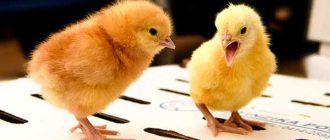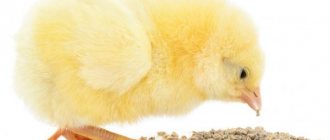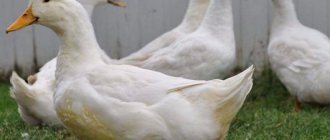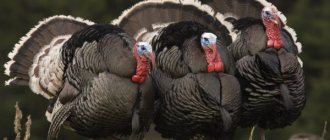1 739
no comments yet
0
Author of the article
Novikov Kirill
Reading time: 4 minutes
Under natural conditions, newly hatched chicks constantly spend time with their mother hen, who protects them not only from dangers, but also from hypothermia.
The difference between chicks from a broody hen and from an incubator
Raising chickens requires certain steps. The situation is simplified if laying hens have maternal instinct.
Such a chicken will conscientiously hatch eggs. And then take care of the hatched chickens and keep them warm.
The poultry farmer just needs to provide proper living conditions and feed them properly. The hen will take care of the brood herself. Will teach you to peck food and drink water.
It's another matter when laying hens refuse to hatch eggs. Therefore, you have to use an incubator.
First, the farmer will be faced with the nuances of incubation. And then - cultivation. Chicks need to be kept at a special temperature to keep them from freezing.
In addition, you will have to monitor the health status of each baby. And learn to peck food. The first few days you need to constantly monitor the chickens. Otherwise they won't survive.
Useful video
Tips for Buying and Raising Chickens
If you find an error, please select a piece of text and press Ctrl+Enter.
Newly born chicks require special attention and care. For rapid adaptation and the beginning of growth in the first days of life, the temperature for chickens should be elevated.
If a mother hen is constantly present next to the chicks, she provides similar “greenhouse” conditions. The hen and the babies should be kept indoors for 2-3 days after their appearance, and then the family is freely released for walking in the warm season, knowing that the chickens will always be protected from cold and bad weather by an adult bird.
But what happens when the chicks come from an incubator? Such chicks are more vulnerable, they have practically no natural resistance to fluctuations in humidity and temperature, and any mistake by the poultry farmer can be fatal. Therefore, as soon as possible after hatching, the chicks are moved to a lighted and heated place, protected from drafts, with dry bedding.
Temperature regime when keeping egg chicks: from a day and as they grow older
Important parameters
When raising chickens at home on a farm, they are kept separately from the rest of the flock in a special box called a brooder. It is recommended to install a thermometer in it so that you can monitor the indicators and adjust them.
Other requirements and standards are described in the article “Rules for keeping chickens in a brooder: temperature and other parameters.”
We reduce the indicators
For the first 5 days the temperature should be about 30 degrees Celsius. Then every day the parameter is gradually reduced. By the 10th day of life, babies need to be at a temperature of 26 degrees.
The indicator continues to decrease by 3 degrees every 7 days. By the month it should be 18 degrees Celsius. These are ideal parameters for healthy development and growth of chicks.
After the onset of the month, the young animals are moved to the main herd. If they live on litter, the room temperature should be 15 degrees. When kept in cages – 18 degrees.
You can make the cage structure yourself. Instructions are described in the article “Assembling a chicken cage with your own hands.”
Are walks necessary?
Egg-laying chickens need sun and a lot of exercise from childhood. So that later there will be high egg production.
Therefore, already from a week of life, the brooder with chickens can be taken outside. But the weather should be sunny and calm. The optimal temperature for walking is 25 degrees.
From the age of two weeks, babies can be kept outside in a pen. But at the slightest deterioration in the weather, they are placed back in the heated brooder.
Month-old chicks can be moved from the brooder to the litter. Its depth should be about 10 cm.
Lighting mode for young chickens
In addition to maintaining an elevated temperature for chicks in the first days of life, constant lighting is important. In this simple way, the bird is encouraged to actively feed and grow. Daylight hours lasting 9–10 hours are gradually achieved by the age of two months, and walks in the sun are very beneficial for chickens, which are a measure of hardening and the prevention of rickets.
Properly selected temperature conditions for chickens, combined with sufficient lighting and diet, are the key to rapid growth, good health and active weight gain.
Heating and lighting are organized in various ways, but an increasing number of poultry farmers tend to prefer red lamps for heating chickens.
Broiler farming
At what temperature are broiler chicks kept?
Now let's talk about temperature for broilers. These chickens are intensively fattened for 2 months. And then they score.
They are given “greenhouse” conditions so that they can live in complete peace and actively gain weight. The table shows the temperature regime for broilers:
Nuances
It is necessary to take into account different indicators in the brooder and in the room with the birds. It is important to maintain temperature conditions for broilers. And do not allow them to move far from the heat source.
It is best to keep meat chickens in a brooder with a thermometer installed. To know exactly what the temperature is. After a month of life, broilers are moved from the brooder to a cage.
Summer and winter care
Broilers can be raised in a cage or on litter. In the second case, the thickness of the litter depends on the time of year. In summer, 5-10 cm is allowed. And in winter, a deeper coating is required - 15-20 cm.
Even in warm summer weather, broiler chickens are not allowed to walk. They are fattened for meat, so their movement is limited. The less broiler chickens walk, the faster they gain the required weight.
After reaching one month of age, broilers are kept at a temperature of 18 degrees. If the room has such indicators, additional heating is not required.
Chick brooder temperature table
Nov 15 • Uncategorized • 46 Views • Comments on the entry Temperature in the brooder for chickens table no
Contents
When chickens are just born, they need special care. Their health is fragile and vulnerable at this time. It is important to maintain the optimal temperature for chickens so that the chicks grow up healthy and can better adapt to independent existence. When they are raised by a hen, she provides the temperature they need to develop. For those chicks that are raised separately, the necessary conditions must be created artificially.
How to maintain temperatures
Basic methods
There are several ways to heat chickens:
- electric or water heating pad;
- various lamps;
- reflectors installed in an inaccessible place;
- a bottle of hot water, wrapped in several layers of gauze or thick fabric.
These devices are enough to heat a brooder with chickens and maintain a comfortable temperature. There's no point in trying. Otherwise the chicks will overheat. This is described in detail below.
Regardless of the heating method, it is necessary to monitor heat sources. The lamp may become too hot. And the water bottle will quickly cool down and stop giving off heat.
In addition, you need to understand that the air will warm up unevenly. The temperature near the heating source is several degrees higher than in the corner of the brooder farthest from it.
When kept in the right temperature conditions, by the month of life, chickens should gain at least 500 g of weight.
Common option
In most cases, infrared (IR) lamps are used to heat chicks.
They are affordable and easy to use. Color has a positive effect on babies and makes them sleep more peacefully. Additionally, the proper level of humidity is maintained in the room.
You can purchase room heating lamps with a red or transparent bulb. Such a device is quite powerful, so it can maintain the required temperature in the brooder.
Service life over 5 thousand hours. Accordingly, it will be possible to raise more than one generation of chickens.
Infrared lamps with a protective bulb reliably heat the brooder and do not fail. They won't suddenly turn off at night, so kids won't get cold.
Learn more in the article “Using Infrared Lamps to Heat a Chicken Coop.”
Other heat sources
To heat day-old and month-old chicks, you can use not only infrared lamps. Luminescent devices have gained popularity. They are more economical, but constantly flicker. This light source may irritate the chicks.
You can install an LED heating system in the brooder. It is economical and lasts a long time. Non-toxic and has a long lasting shimmer. LED lamps allow you to adjust the lighting in the brooder. But the farmer will have to spend a lot of money on such a device.
Combination lamps combining ultraviolet and infrared radiation are common. This device is useful for young animals because it has disinfecting properties and kills pathogenic microbes.
In addition, the combined device has a positive effect on the development of babies and calms the nervous system.
These and other heat sources are discussed in the article “Lamps and other devices for heating chickens.”
Installation of the device
When using lamps to heat a brooder, you need to understand that the higher it is fixed, the weaker it will heat. Therefore, it will have to be moved as the young animals grow older.
For day-old chicks, the height of the heating device should be 50 cm from the floor. This parameter must be maintained for 7 days. From 2-3 weeks, the lamp is raised to a height of 75 cm. The chickens have grown, so the air temperature needs to be reduced.
Then the lamp is fixed at a height of 1 meter. Thus, the air temperature in the brooder decreases. But a large area is heated and illuminated.
Terms of use
When installing lamps, safety precautions must be observed.
They must be completely safe, protected from moisture and shock. Chickens are very curious. Therefore, they will constantly approach the source of light and heat. Every possible action must be taken to prevent accidents.
You must also remember that lamps can cause a fire, which will lead to a disastrous outcome.
If the farmer decides to install an infrared or any other lamp in the brooder, it must be covered with a lattice housing. And hang it at a height inaccessible to chickens.
Main causes of death
When chickens are born and the hen does not care for them, then with insufficient care, the death of the feathered population is possible.
This happens for the following reasons:
- If the chicks are not cared for properly.
- If the diet is incorrect, then it is also dangerous for them.
- A chicken's internal organs are very delicate. The slightest damage poses a danger to their life. One possible danger is gastric blockage. For example, this will happen if a pebble is swallowed.
- Due to weak immunity, infectious diseases can be fatal. Treatment is usually ineffective at this age. Here, only preventive measures are usually used.
- Infection with pullorosis occurs at the stage of development when the egg matures. Then a sick chick is born. Almost everyone infected with this disease does not survive.
- Sometimes, with insufficient care, chickens begin to peck each other. First, the chicks pluck each other's feathers, then injure each other with bites, pinching off pieces of their bodies. After this, infection usually occurs and the chickens die.
- Foods included in the diet may contain pesticides that are harmful to chickens. If an inexperienced farmer feeds birds with greens on which pesticides remain, then this threatens them with death. Symptoms of poisoning include the following: parts of the body turn blue, wings droop, and birds die from suffocation.
- If the diet does not have enough vitamins A and B, and there is no calcium and phosphorus in the required quantities, then the chickens develop toxic gastric dyspepsia. In the initial stage, the temperature rises, the chicks walk sleepy and droop their wings. Death occurs as a result of muscle spasms.
- If chickens are fed only soft food and no solids in their diet, it will lead to stomach atrophy. This is expressed in the following symptoms: the birds develop severe thirst, the chicks walk around ruffled, and lose weight. If no measures are taken, then death occurs.
Chickens have a very weak body. To help them survive, it is necessary to take good care of them, providing them with everything they need.
In the first days and weeks of their lives, chicks die very easily - they catch a cold from any draft and contract various diseases. Therefore, in the absence of proper care for day-old chicks, their mortality rate approaches one hundred percent.
Note! Newborn chickens are vaccinated in the first days of their life. Before vaccination, you should consult with your veterinarian to select the right medications.
Reasons for high chicken mortality:
- infectious and parasitic diseases (in particular, coccidiosis);
- larger animals (both predators and, for example, domestic cats);
- colds caused by temperature changes;
- digestive problems and subsequent diseases.
How to tell if birds are cold or hot
By the behavior of children you can understand how they feel.
If the room is cold and the chicks are cold, they try to stay closer to each other. Usually there is a crowd at one feeder or drinking bowl. And others remain untouched. The frozen chicken does not fit to the edge of the box. He, along with everyone else, is near the heat source.
If you set the room temperature too hot, your baby's activity will noticeably decrease. They will move as far away from the heating device as possible. Fall asleep while walking or near the drinking bowl.
When overheated, chickens refuse water and food. Kids can crowd together, but they do it around the perimeter.
Overheated or frozen: what to do
If, based on the above signs, it becomes clear that the babies are overheated, you need to immediately move them away from the heat source.
You can gently wipe the chicks with a soft cloth dipped in cool water. But not in the cold, otherwise the kids will catch a cold.
Make a bath out of a bowl of water and place the chickens in it. Also try to give the kids something to drink. If they refuse, add water through a pipette.
If the chicks are cold, you need to move them to a heat source and gently rub them with your hand. When the chicks warm up and come to their senses, try to feed them. So that the body receives energy for heating.
What to feed to keep you warm
Chickens get their energy from food, so proper diet should not be neglected. Products should be as crushed as possible so that babies can swallow them.
From the first days of life, chickens can be given various cereals. The main thing is not to mix. Porridge from one type of cereal is allowed per meal. The hatched babies are given a boiled yolk mixed with corn grits, semolina or millet.
Birds need finely chopped greens, which are first washed under cold water and scalded with boiling water. Crushed dandelion or nettle mixed with granular cottage cheese is used.
Week-old chickens are given wet mash and chopped vegetables. This diet is enough to obtain the energy spent on heating the body.
Detailed information about the menu is in the article “What to feed chickens at home from the first days of life.”











